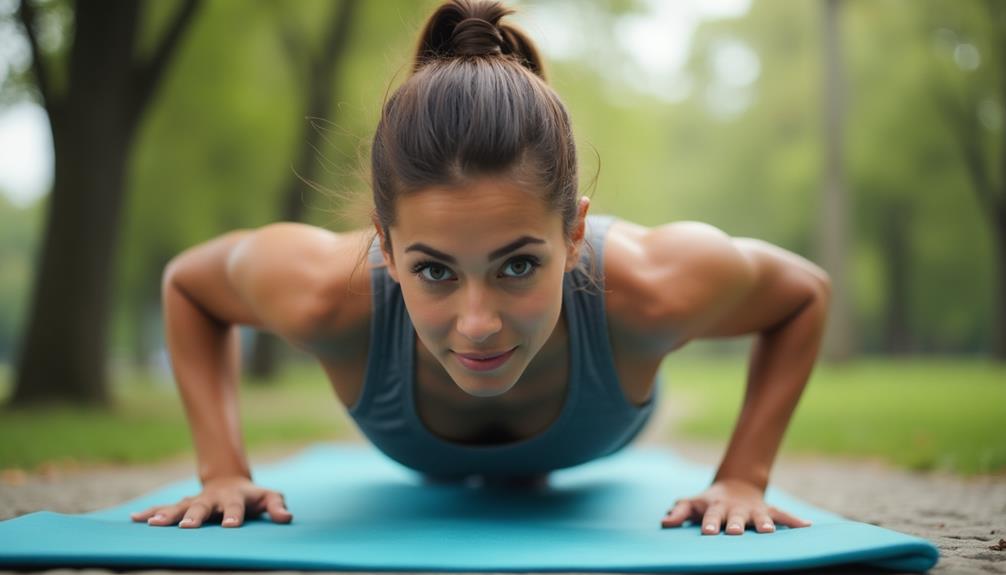Mastering bodyweight resistance exercises is a practical way to enhance your fitness without equipment. Start by understanding the benefits, like engaging multiple muscle groups and improving core stability. Before you jump in, warm up with light cardio and dynamic stretches. Begin with fundamental exercises such as push-ups, squats, and planks. Progress gradually, mastering basics before moving to intermediate techniques like Pike push-ups and single-leg squats. As you advance, explore challenging movements like one-arm push-ups. Remember to structure your workouts, avoid common mistakes, and prioritize recovery. There's much more to uncover as you refine your routine.
Core Insights
- Begin with essential warm-up routines to prepare your muscles and reduce the risk of injury before starting bodyweight exercises.
- Focus on mastering fundamental exercises like push-ups, squats, and planks to build a strong foundation.
- Progress gradually by introducing easier variations of exercises, ensuring proper form and technique.
- Incorporate intermediate techniques such as pike push-ups and single-leg squats to challenge strength and stability.
- Explore advanced variations like one-arm push-ups and pistol squats to push your limits and enhance overall fitness.
Benefits of Bodyweight Training
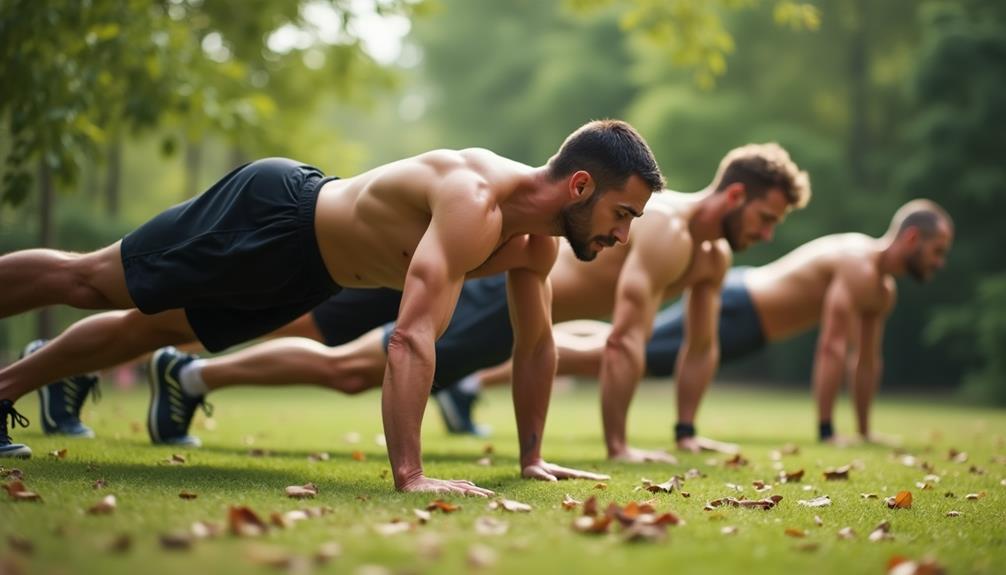
Why should you consider bodyweight training?
Bodyweight training offers numerous benefits that can enhance your fitness journey. To start with, it requires no equipment, making it accessible anywhere. You can easily incorporate exercises into your daily routine, whether at home or outdoors. Unlike resistance tubes, which provide stackable resistance options, bodyweight exercises use your own weight as resistance, allowing for natural progression as you build strength.
Additionally, bodyweight workouts improve your strength, flexibility, and balance. They engage multiple muscle groups, promoting functional strength that translates to everyday activities.
This type of training is also scalable; you can adjust the intensity to match your fitness level, ensuring steady progress.
Moreover, bodyweight exercises boost core stability and endurance, which are essential for overall fitness.
Lastly, they promote body awareness, helping you develop a better connection with your movements.
Essential Warm-Up Routine
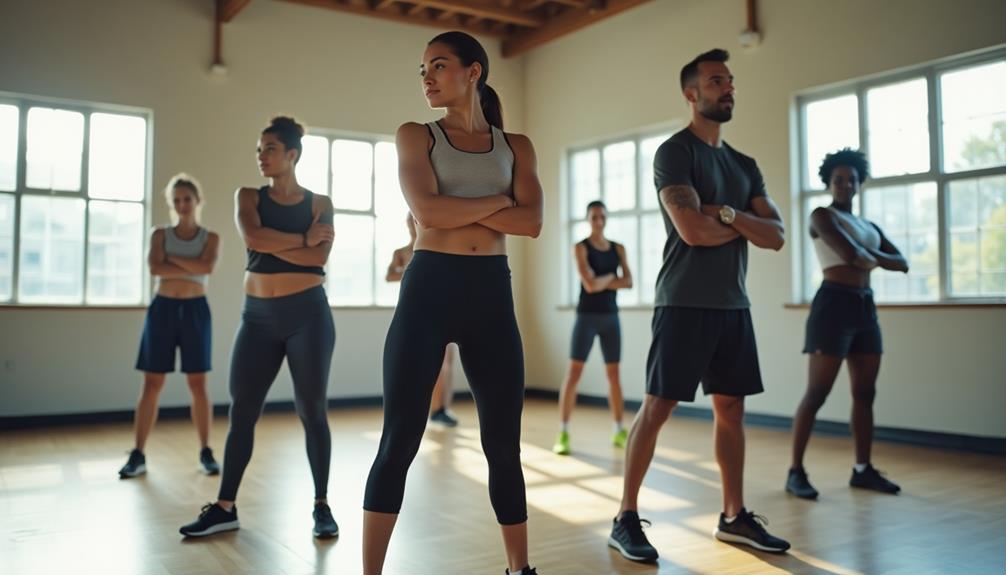
A solid warm-up routine is essential for preparing your body for bodyweight resistance exercises. Start with five to ten minutes of light cardio, like brisk walking or jogging in place. This increases your heart rate and circulation. Next, focus on dynamic stretches. Perform arm circles, leg swings, and torso twists to loosen up your joints and muscles. Consider incorporating targeted compression sleeves for specific areas like calves or knees to enhance your warm-up and provide support during exercises.
Incorporate movements that mimic the exercises you'll do later. For example, include bodyweight squats and lunges. These prepare your muscles for the specific demands ahead.
Fundamental Bodyweight Exercises
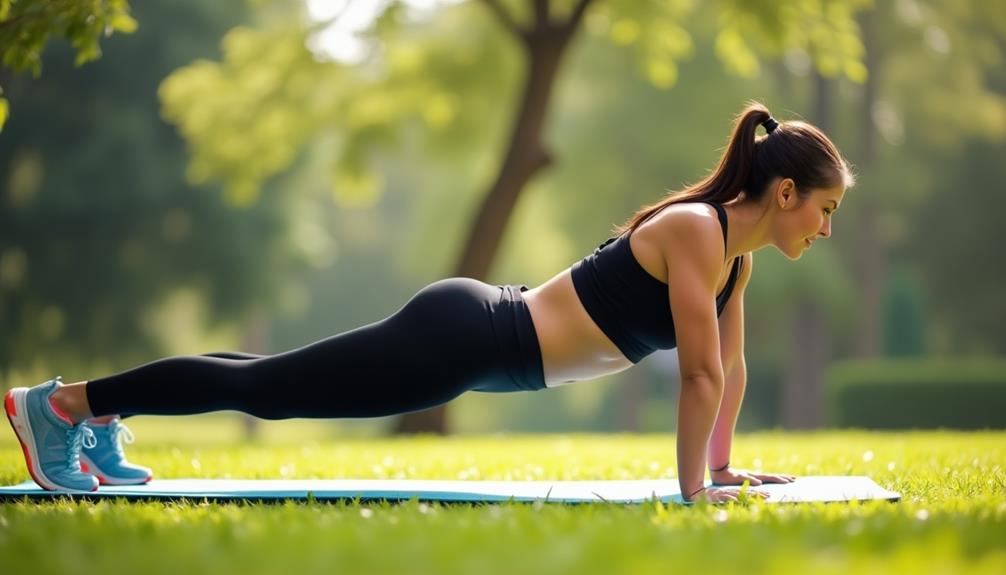
Whether you're new to fitness or looking to enhance your routine, fundamental bodyweight exercises can build strength and endurance without the need for equipment. These movements engage multiple muscle groups, making them efficient and effective. For those seeking an extra energy boost during workouts, caffeine pills can provide sustained focus and alertness. However, it's important to take into account your tolerance and consult a healthcare provider before use. Here are four essential bodyweight exercises to get you started:
- Push-Ups: Target your chest, shoulders, and triceps. Maintain a straight line from head to heels.
- Squats: Strengthen your legs and glutes. Keep your feet shoulder-width apart and lower your body as if sitting back in a chair.
- Planks: Work your core and improve stability. Hold a straight position on your forearms and toes.
- Lunges: Enhance leg strength and balance. Step forward and lower your back knee toward the ground.
Incorporate these exercises into your routine for a strong foundation!
Progressions for Beginners
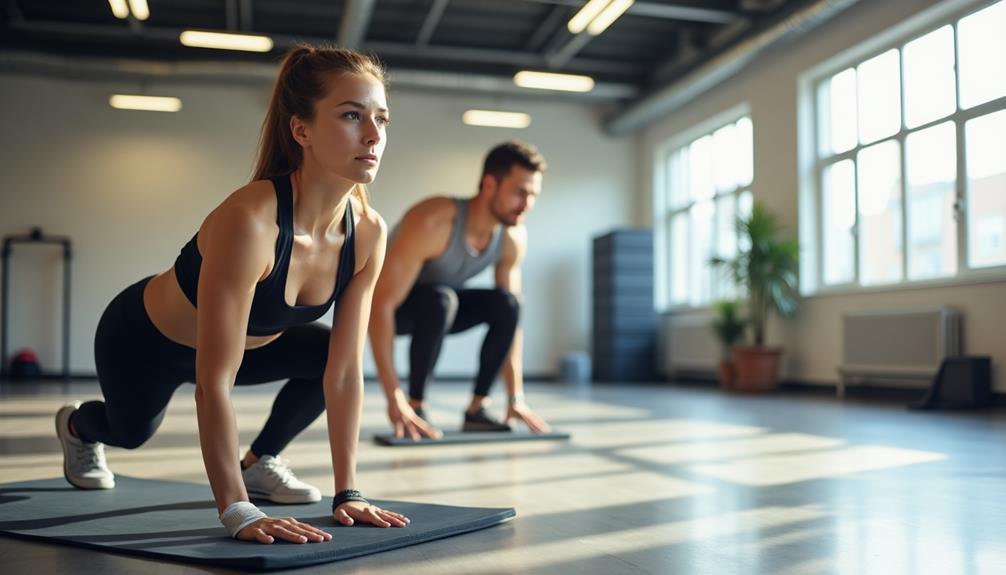
Progressing through bodyweight resistance exercises not only builds confidence but also enhances your overall fitness journey. As a beginner, initiating with fundamental movements like push-ups, squats, and planks is crucial. Focus on mastering these basics before moving forward.
- Push-Up Progression: Start with wall push-ups, then advance to knee push-ups, and finally, standard push-ups.
- Squat Progression: Begin with chair squats, advance to bodyweight squats, and then attempt single-leg squats.
- Plank Progression: Start with knee planks, then progress to full planks, and eventually include side planks.
Intermediate Bodyweight Techniques
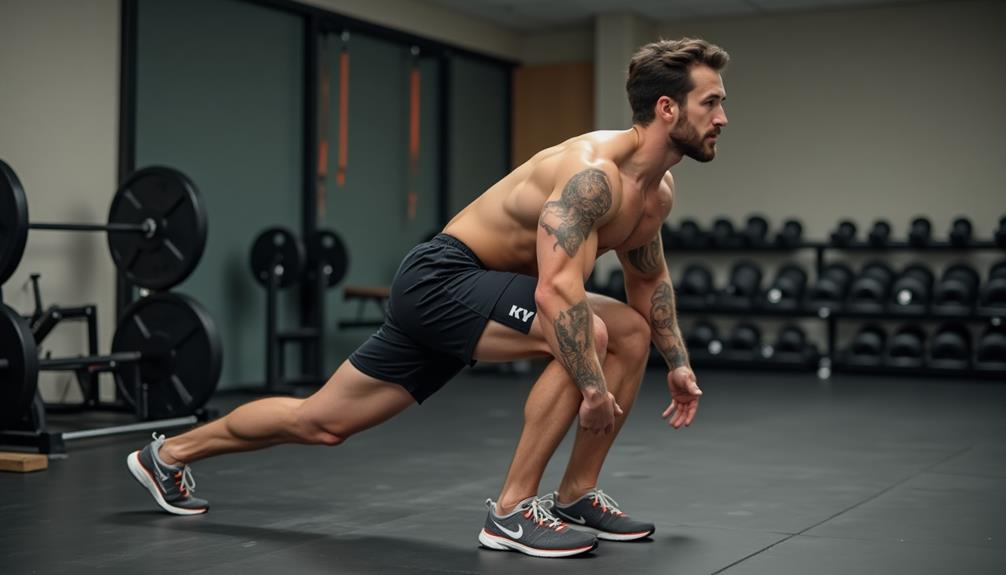
Once you've mastered the basics, incorporating intermediate bodyweight techniques can greatly enhance your workout routine. These exercises challenge your strength and stability, pushing your limits further. Here are four effective techniques to try:
- Pike Push-Ups: Elevate your hips to target your shoulders more intensely.
- Single-Leg Squats: Build balance and strength by lowering your body on one leg.
- Plank to Push-Up: Shift between a plank and push-up position to engage your core and upper body.
- Burpees: Combine a squat, push-up, and jump for a full-body workout that boosts your heart rate.
Advanced Movement Variations

| Exercise | Target Muscles | Benefits |
|---|---|---|
| One-Arm Push-Up | Chest, Triceps | Increases unilateral strength |
| Pistol Squat | Quads, Glutes | Enhances balance and flexibility |
| Handstand Push-Up | Shoulders, Core | Builds upper body strength |
| Archer Pull-Up | Back, Biceps | Develops pulling strength |
| Tuck Planche | Core, Shoulders | Improves overall body control |
Incorporate these movements gradually, focusing on form and technique to maximize your gains.
Structuring Your Workout
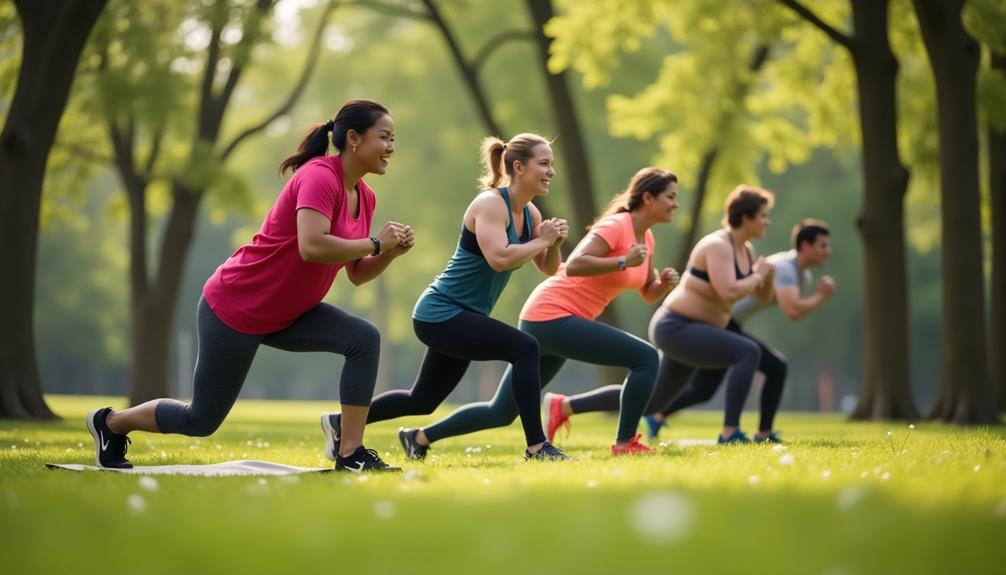
- Warm-Up: Spend 5-10 minutes warming up to prepare your muscles.
- Core Exercises: Start with core movements like planks or mountain climbers to engage your center.
- Upper Body: Include push-ups or dips to strengthen your arms and chest.
- Lower Body: Finish with squats or lunges to work your legs.
Common Mistakes to Avoid

When it comes to bodyweight resistance exercises, avoiding common mistakes can make a significant difference in your results and safety. One key error is neglecting proper form. Poor technique can lead to injuries and reduced effectiveness. Always prioritize alignment and control in every movement.
Another mistake is rushing through your workouts. Take your time to make sure each rep is executed correctly. This approach enhances muscle engagement and prevents strain.
Additionally, don't forget to warm up before you start. Skipping this essential step increases your risk of injury. To end, be mindful of your limits. Pushing too hard can lead to burnout or injury. Listen to your body, and allow for adequate rest between sessions. By avoiding these pitfalls, you'll maximize your progress and stay safe.
Recovery and Flexibility Tips

Recovery is just as vital as the workouts themselves in bodyweight resistance training. Without proper recovery, you risk injury and hinder your progress. Here are some effective tips to enhance your recovery and flexibility:
- Hydrate: Drink plenty of water before, during, and after workouts to support muscle recovery.
- Stretch: Incorporate dynamic stretches before your workout and static stretches afterward to improve flexibility.
- Rest: Make sure you get adequate sleep each night. Aim for 7-9 hours to allow your muscles to repair.
- Foam Roll: Use a foam roller post-workout to relieve muscle tightness and improve blood flow.
Creating a Sustainable Routine
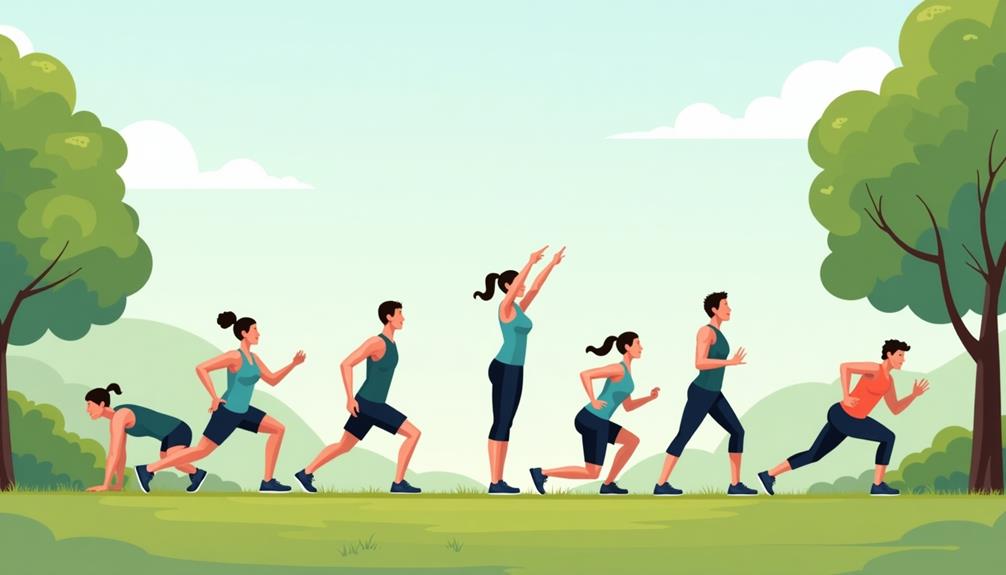
| Day | Exercise Type | Duration |
|---|---|---|
| Monday | Upper Body | 30 minutes |
| Wednesday | Lower Body | 30 minutes |
| Friday | Core and Flexibility | 30 minutes |
Frequently Asked Questions
Can Bodyweight Exercises Help With Weight Loss?
Think of bodyweight exercises as a powerful tool in your fitness toolbox. They can boost your metabolism, burn calories, and help shed pounds, all while building strength and endurance. You'll see results with consistency!
How Often Should I Perform Bodyweight Workouts?
You should aim to perform bodyweight workouts three to five times a week. This frequency helps build strength and endurance while allowing your body enough recovery time to avoid injury and promote overall fitness.
Do I Need Equipment for Bodyweight Training?
You don't need any equipment for bodyweight training. Your body provides all the resistance you require. Just find some space, and you're set to start a great workout anytime, anywhere.
Are Bodyweight Exercises Safe for Seniors?
Yes, bodyweight exercises can be safe for seniors when done with proper form and modifications. You should start slowly, listen to your body, and consult a healthcare professional if you have any concerns.
What Is the Best Time of Day for Workouts?
The best time of day for workouts really depends on when you feel most energized. Some folks prefer mornings to kickstart their day, while others find evenings work better for unwinding after a long day.

